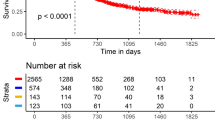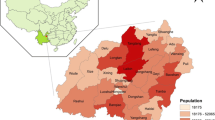Abstract
Xuanwei City (formerly known as Xuanwei County) locates in the northeastern of Yunnan Province and is rich in coal, iron, copper and other mines, especially the smoky (bituminous) coal. Unfortunately, the lung cancer morbidity and mortality rates in this region are among China’s highest, with a clear upward trend from the mid-1970s to mid-2000s. In 2004–2005, the crude death rate of lung cancer was 91.3 per 100 000 in the whole Xuanwei City, while that for Laibin Town in this city was 241.14 per 100 000. The epidemiologic distribution (clustering patterns by population, time, and space) of lung cancer in Xuanwei has some special features, e.g., high incidence in rural areas, high incidence in females, and an early age peak in lung cancer deaths. The main factor that associates with a high rate of lung cancer incidence was found to be indoor air pollution caused by the indoor burning of smoky coal. To a certain extent, genetic defects are also associated with the high incidence of lung cancer in Xuanwei. Taken together, lung cancer in this smoky coal combustion region is a unique model for environmental factor-related human cancer, and the current studies indicate that abandoning the use of smoky coal is the key to diminish lung cancer morbidity and mortality.
Similar content being viewed by others
References
Jemal A, Bray F, Center MM, Ferlay J, Ward E, Forman D. Global cancer statistics. CA Cancer J Clin 2011; 61(2): 69–90
Zhou YS. Lung Cancer. Beijing: People’s Medical Publishing House. 1980
Chen Z. The Third Chinese National Retrospective Surveys for the Causes of Death. Beijing: Peking Union Medical College Press. 2008
Pavlish JH, Sondreal EA, Mann MD, Olson ES, Galbreath KC, Laudal DL, Benson SA. Status review of mercury control options for coal-fired power plants. Fuel Process Technol 2003; 82(2–3): 89–165
Marzec A. Towards an understanding of the coal structure: a review. Fuel Process Technol 2002; 77–78: 25–32
Page K. Blood on the coal: the effect of organizational size and differentiation on coal mine accidents. J Safety Res 2009; 40(2): 85–95
Attfield MD, Seixas NS. Prevalence of pneumoconiosis and its relationship to dust exposure in a cohort of U.S. bituminous coal miners and ex-miners. Am J Ind Med 1995; 27(1): 137–151
McCunney RJ, Morfeld P, Payne S. What component of coal causes coal workers’ pneumoconiosis? J Occup Environ Med 2009; 51(4): 462–471
Santo Tomas LH. Emphysema and chronic obstructive pulmonary disease in coal miners. Curr Opin Pulm Med 2011; 17(2): 123–125
Cao Y, Gao H. Prevalence and causes of air pollution and lung cancer in Xuanwei City and Fuyuan County, Yunnan Province, China. Front Med 2012; 6(2): 217–220
Mumford JL, He XZ, Chapman RS, Cao SR, Harris DB, Li XM, Xian YL, Jiang WZ, Xu CW, Chuang JC, et al. Lung cancer and indoor air pollution in Xuan Wei, China. Science 1987; 235(4785): 217–220
Liang CK, Quan NY, Cao SR, He XZ, Ma F. Natural inhalation exposure to coal smoke and wood smoke induces lung cancer in mice and rats. Biomed Environ Sci 1988; 1(1): 42–50
Mumford JL, Helmes CT, Lee XM, Seidenberg J, Nesnow S. Mouse skin tumorigenicity studies of indoor coal and wood combustion emissions from homes of residents in Xuan Wei, China with high lung cancer mortality. Carcinogenesis 1990; 11(3): 397–403
He XZ, Chen W, Liu ZY, Chapman RS. An epidemiological study of lung cancer in Xuan Wei County, China: current progress. Casecontrol study on lung cancer and cooking fuel. Environ Health Perspect 1991; 94(8): 9–13
Lan Q, Chapman RS, Schreinemachers DM, Tian L, He X. Household stove improvement and risk of lung cancer in Xuanwei, China. J Natl Cancer Inst 2002; 94(11): 826–835
Dong ZW, Qiao YL, Li LD, Wang GQ, Zhang SW, Meng XZ, Li JB. A report of cancer high incidence scene in China. China Cancer (Zhongguo Zhong Liu) 2009; 18(1): 4–5 (in Chinese)
Luo RQ, Zhao TD. An analysis on the trend of mortality with lung cancer in 9 counties of Yunnan Province. China Cancer (Zhongguo Zhong Liu) 2002; 11: 700–701 (in Chinese)
Yang L, Li LD, Chen YD, Parkin DM. Cancer incidence and mortality estimates and prediction for year 2000 and 2005 in China. Chin J Health Stat (Zhongguo Wei Sheng Tong Ji) 2005; 22: 218–219 (in Chinese)
Hao JH, Huang YC, Ren HX, Chen Y, Hao X, Shi QP, Xiao YZ. Trend analysis of lung cancer mortality in areas with high incidence from 1973 to 2005. Chinese Gen Pract (Zhongguo Quan Ke Yi Xue) 2009; 12(24):2279–2282 (in Chinese)
Ning BF. Epidemioiogical analysis of lung cancer in Xuanwei from 1990–1992. China J Cancer Prev Treat (Zhong Liu Fang Zhi Za Zhi) 2001; 8(4): 178–190 (in Chinese)
He XZ, Lan Q, Yang RD, Li RF, Huang CF. An overview of studies on risk factors for lung cancer in Xuanwei, China (1979-1993). J Hyg Res(Wei Sheng Yan Jiu) 1995; 24(4): 203–206 (in Chinese)
Li JH, Zhang YS, Li Y, Yin G, Li Y, Ning B, Guo J. Descriptive study on the epidemiology of lung cancer in coal-producing area in eastern Yunnan, China. Chinese J Lung Cancer (Zhongguo Fei Ai Za Zhi) 2011; 14(2): 107–119 (in Chinese)
Wang ZJ. Epidemiology of Lung Cancer. China J Cancer Prev Treat (Zhong Liu Fang Zhi Za Zhi) 2002; 9(1): 1–5 (in Chinese)
Howlader N, Noone AM, Krapcho M, et al. SEER Cancer Statistics Review, 1975–2009 (Vintage 2009 Populations). National Cancer Institute. Bethesda, MD, http://seer.cancer.gov/csr/1975_2009_pops09/, based on November 2011 SEER data submission, posted to the SEER web site, April 2012
He XZ, Yang RD. Lung cancer and indoor air pollution from coal burning. Kunming: Yunnan Science and Technology Press. 1994
Blot WJ, Fryzek JP, Henderson BE, Sadler CJ, McLaughlin JK. A cohort mortality study among gas generator utility workers. J Occup Environ Med 2000; 42(2): 194–199
Cohen BL. Testing a BEIR-VI suggestion for explaining the lung cancer vs. radon relationship for U.S. counties. Health Phys 2000; 78(5): 522–527
Gerken M, Kreienbrock L, Wellmann J, Kreuzer M, Wichmann HE. Models for retrospective quantification of indoor radon exposure in case-control studies. Health Phys 2000; 78(3): 268–278
Gilliland FD, Hunt WC, Pardilla M, Key CR. Uranium mining and lung cancer among Navajo men in New Mexico and Arizona, 1969 to 1993. J Occup Environ Med 2000; 42(3): 278–283
Danielsen TE, Langård S, Andersen A. Incidence of cancer among welders and other shipyard workers with information on previous work history. J Occup Environ Med 2000; 42(1): 101–109
Brüske-Hohlfeld I, Möhner M, Pohlabeln H, Ahrens W, Bolm-Audorff U, Kreienbrock L, Kreuzer M, Jahn I, Wichmann HE, Jöckel KH. Occupational lung cancer risk for men in Germany: results from a pooled case-control study. Am J Epidemiol 2000; 151(4): 384–395
Sun SQ. Etiology of lung cancer at the Gejiu tin mine, China. Princess Takamatsu Symp 1987; 18: 103–115
Lin HP, Xie MT, Wu XY, Liu ZQ, Wang JJ, Jiang RY, Gao ZL. Health risk assessment of polycyclic aromatic hydrocarbons (PAHs) pollution in air in Xuanwei, China. J Environ Health (Huan Jing Yu Jian Kang Za Zhi) 2010; 27(6): 511–513 (in Chinese)
He XZ. Correlation of indoor air pollution caused by indoor burning of smoky coal to genetic susceptibility of lung cancer- Advance in etiology of lung cancer for 22 years in Xuanwei. J Pract Oncol (Shi Yong Zhong Liu Za Zhi) 2001; 16(6): 369–370 (in Chinese)
Lan Q, Tian LW, He XZ, Yang RD, Li RF, Huang ZF. Primary Prevention Strategy and Reduction of Lang Cancer Risk: Intervention Effect Assessment of the Stove Improvement in Xuanwei County. Chin J Publ Health (Zhongguo Gong Gong Wei Sheng) 1999; 15(2): 116–119 (in Chinese)
Hosgood HD 3rd, Wei H, Sapkota A, Choudhury I, Bruce N, Smith KR, Rothman N, Lan Q. Household coal use and lung cancer: systematic review and meta-analysis of case-control studies, with an emphasis on geographic variation. Int J Epidemiol 2011; 40(3): 719–728
Jin YT, He XZ, Zhou XT. Analysis of the familial risk factors on lung cancer. Chin J Lung Cancer (Zhongguo Fei Ai Za Zhi) 2002; 5(2): 83–86 (in Chinese)
Jin YT, Zhou XT, He XZ. The general measurement of genetic factors on lung cancer in Xuanwei, China. Chin J Lung Cancer (Zhongguo Fei Ai Za Zhi) 2001; 4(5): 354–356 (in Chinese)
Jin YT, Zhou XT, He XZ. Genetic epidemiology of lung cancer in Xuanwei. Chin J Publ Health (Zhongguo Gong Gong Wei Sheng) 1996; 12(12): 537–539 (in Chinese)
Jin YT, He XZ. Analysis on lung cancer in 370 core family members. J Hyg Res(Wei Sheng Yan Jiu) 1996; 25: 271–273 (in Chinese)
Jin YT, Zhou XT, He XZ. Genetic epidemiology study on lung cancer in women. Chin J Prev Control Chronic Non-Commun Dis (Zhongguo Man Xing Bing Yu Fang Yu Kong Zhi) 1998; 6: 5–7 (in Chinese)
Liu BQ, Peto R, Chen ZM, Boreham J, Wu YP, Li JY, Campbell TC, Chen JS. Emerging tobacco hazards in China: 1. Retrospective proportional mortality study of one million deaths. BMJ 1998; 317(7170): 1411–1422
Shen Y, Shen Y. Occupational impact of pathology and age of onset of female lung cancer in Xuanwei and Yunxi, China. Clin Focus (Lin Chuang Hui Cui) 1999; 14(1): 12 (in Chinese)
Deng ZH, Huang ZH, Zeng QX, Yang DY, He XZ, Wang SW, Yin YW. Epidemiology of radon in indoor air pollution and gammaradiation from surface on lung cancer. Chin J Radiol Med Prot (Zhonghua Fang She Yi Xue Yu Fang Hu Za Zhi) 2001; 21(5): 389–391 (in Chinese)
Boström CE, Gerde P, Hanberg A, Jernström B, Johansson C, Kyrklund T, Rannug A, Törnqvist M, Victorin K, Westerholm R. Cancer risk assessment, indicators, and guidelines for polycyclic aromatic hydrocarbons in the ambient air. Environ Health Perspect 2002; 110(Suppl 3): 451–488
Zhang Y, Tao S. Global atmospheric emission inventory of polycyclic aromatic hydrocarbons (PAHs) for 2004. Atmos Environ 2009; 43(4): 812–819
Author information
Authors and Affiliations
Corresponding authors
Rights and permissions
About this article
Cite this article
Xiao, Y., Shao, Y., Yu, X. et al. The epidemic status and risk factors of lung cancer in Xuanwei City, Yunnan Province, China. Front. Med. 6, 388–394 (2012). https://doi.org/10.1007/s11684-012-0233-3
Received:
Accepted:
Published:
Issue Date:
DOI: https://doi.org/10.1007/s11684-012-0233-3




